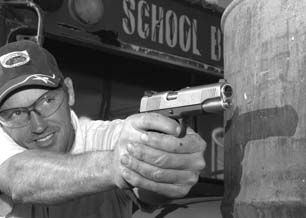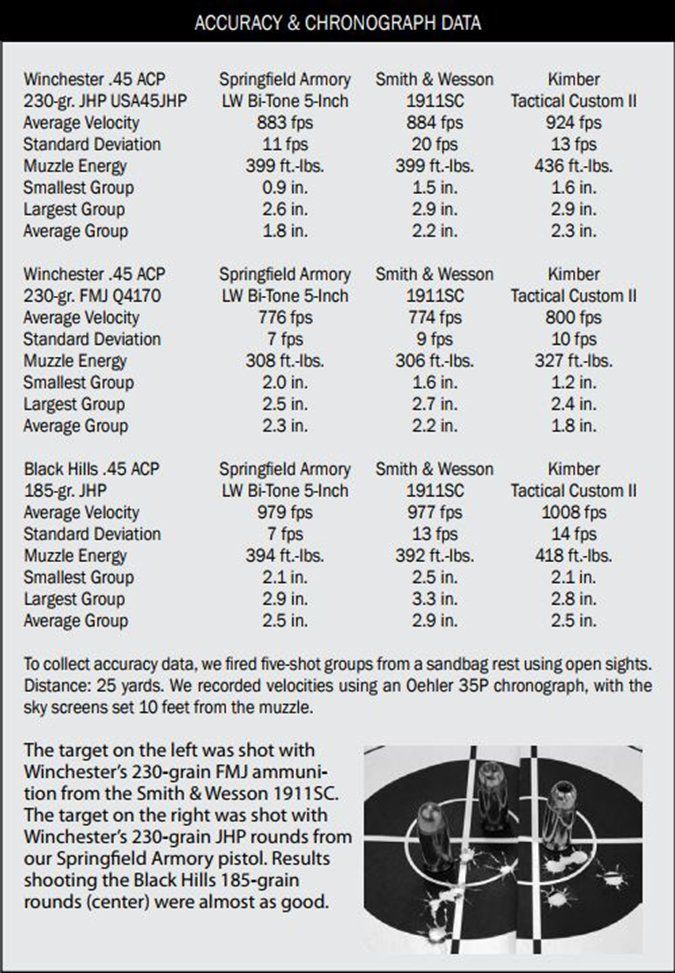
In this report the Smith & Wesson 1911SC will be matched head to head with Springfield Armory’s Service Model 5-inch Lightweight Bi-Tone pistol. We will also reflect upon our recent test of the Kimber Tactical Custom II and bring our findings of the three pistols up to date. The ammunition used to test-fire the Springfield Armory and Smith & Wesson pistols was the same selection used in our test of the Kimber published in the November 2005 issue. The Kimber was re-chronographed along with our current two pistols to account for the change in temperature between test dates. consisted of Winchester’s 230-grain FMJ and JHP rounds plus 185-grain JHP rounds from Black Hills Ammunition. Test distance was once again 25 yards from a bench rest. Since each of our guns was priced above $900 MSRP, we expected tight groups without malfunctions or breakage. If each gun came through as expected would we be able to make a clear choice? Only the shooting will tell.
The term “Service model” may sound austere, but this pistol was closer to Springfield’s Loaded series than a basic model. The most striking aspect of this pistol was its matte-stainless top end and black-Parkerized alloy receiver. Springfield polished the barrel hood and cut out metal in the hood to serve as a loaded chamber indicator, but left the rest of the barrel black. A dark coating covered the firing-pin retainer and extractor, and cocking serrations front and rear appeared on the slide.
At $934, the Springfield cost less than the Smith & Wesson 1911SC, but the Bi-Tone included Novak night sights front and rear. Springfield dovetailed and staked the front sight into place. The front sight incorporated glare-cutting lines into its face surrounding the tritium module. The dark cocobolo grips included sharp checkering, and matching Allen screws held the grips in place. Vertical cuts provided a non-slip surface on the flat mainspring housing, and a key-operated mainspring lock appeared just below the grip safety. The smooth front strap felt narrower than our other two guns. Springfield expertly beveled the magazine well for smoother loading, and controls such as the slide stop, high beavertail with raised platform, and ambidextrous safeties matched the dark frame. We noted overtravel screws on the aluminum trigger shoes on both guns, and the Bi-Tone’s trigger employed vertical lines on its face and was lightened with three large holes. Both guns utilized a bushing to lock up the barrel, and both sported a full-length guide rod.
But the Springfield’s two-piece guide rod required a specific breakdown procedure. First, we locked back the slide and used a 5/32-inch Allen wrench to loosen the front portion of the guide rod. Then we moved the slide forward and unscrewed and removed the rod. We found that compressing the recoil spring retainer and rotating the bushing was not difficult, but most people will prefer to use a bushing wrench, which was not supplied. After removing the recoil spring, we shifted the slide to the rear to align the disassembly notch and remove the slide stop. The slide was now free.
Assembly was the reverse of this process, but it’s a good idea to lock back the slide before tightening down the front portion of the guide rod. For testing purposes we tried shooting the Springfield with the guide rod completely loose, but the gun continued to run without malfunction throughout our test.
The gun came with two seven-round magazines, but the Bi-Tone accepted larger capacity magazines.
At the range we discovered that the accuracy of the Springfield equaled that of the more expensive Kimber Tactical Custom II. The Springfield shot groups averaging 1.8 inches with the Winchester 230-grain hollowpoints and 2.3 inches with the Winchester 230-grain full-metal jacketed rounds. Results shooting the Kimber were exactly the reverse, favoring the FMJ rounds. Both the Kimber and the Springfield shot 2.5-inch groups on average when firing the 185-grain JHP rounds. The Smith & Wesson shot both Winchester rounds into an average group measuring 2.2 inches. These are very good results across the board. However, the Springfield and the Smith & Wesson 1911SC lagged slightly behind the Kimber in terms of power — about 32 fps on average when compared with the Kimber.

The Springfield’s the trigger had a well defined, predictable takeup and controllable break. In dim light, we could see the Novak night sights clearly and got clear definition of the front sight.
On the hip, the narrower Springfield was a better fit in the variety of holsters we tried. As a result, our testers thought the Springfield carried the best of all three guns. We liked the aggressively checkered grips, but we would have also preferred a checkered front strap.
The Smith & Wesson 1911SC is a full-size 5-inch barrel .45 with a couple of significant differences from the Springfield Armory pistol. Notably, the extractor rode fully exposed rather than being housed inside the slide to the right of the firing pin channel. The previously tested Kimber also had an external extractor, but the Smith & Wesson extractor’s entire length, about 1.2 inches, sat fully exposed along the right-hand surface of the slide. A pin, shielded in a recess atop the slide located about 0.7 inch back from the claw end, held the extractor. We experienced no malfunctions of any kind during the test, and we did not observe any degree of wear or abrasion to the pin’s outer surface.
Next, the grip-operated firing-pin safety appeared to be different from the design found on the Kimber pistol. Upward motion on the S&W’s safety, created by compressing the grip safety, pushed against the plunger to release the firing pin in a more complicated system, we thought. The piece that pushes upward on the Kimber was solid with the grip safety. Releasing the grip safety of the Smith & Wesson, we discovered that there was an intermediate lever that floats instead of following the grip safety down to its rest position. This made reapplying the slide to the frame more difficult. This intermediate lever had to be compressed forcefully before the slide was able to pass over it. Otherwise, field stripping was typical, requiring a bushing wrench (supplied) to release the recoil spring.
The 1911SC came with two eight-round magazines with full base pads. Each gun in this category offered a relief atop the barrel hood for checking loaded condition. But the viewing notch in the 1911SC was the largest and by far the best, in our view.
The clear-anodized finish on the 1911SC’s stainless-steel slide had a sparkly matte finish, and the frame was a nonreflective matte, according to Smith & Wesson, for better concealed-carry purposes. S&W says the frame material is scandium alloy, actually a mix of aluminum and scandium. The advantage of adding scandium to aluminum was increased elasticity, making the material less vulnerable to cracking under stress. None of our guns suffered any cracks or other breakage.
In terms of features, our 1911SC came up a little short when compared to the Springfield Armory or the Kimber pistols. The thumb safety was left side only, and we felt the operation was not as tight or as sure as on our other pistols. But it never strayed from its set position in the holster or at the bench. Slotted screws held the grips in place, and the wood did not seem to be as high grade as on the other pistols. One panel was cut less precisely than the other and didn’t fit as well. But the back strap showed 20-lpi checkering, and vertically lines cut the front strap. The face of the front strap felt wider than the Springfield, and this may have helped disperse recoil. Our shooters felt that the Smith & Wesson was slightly more controllable. All three guns offered snag-resistant sights, but the Smith came with a three-white-dot system. A look at our accuracy data tells us that the 1911SC was a little behind shooting the 185-grain rounds. But our five-shot groups firing both 230-grain rounds was consistent, with groups measuring between 1.5 and 2.9 inches. Pretty good, considering that the sights did not provide a fine sight picture, in our opinion.
There was not much light visible between the edges of the front sight and the rear notch, we thought. With a thinner front sight, we might have been able to shoot tighter groups. The trigger did not present a crisp break to the shooter, but rather a softer compression. Some of our shooters preferred this feel.
Overall, our impression was that most shooters would rather not have to struggle with the mechanism of the grip safety as it connects to the firing pin safety. Also, some of our test team didn’t feel as sure operating the thumb safety. Sights are a matter of choice, and the supplied units were adequate, but perhaps below what we would expect on a $1000 pistol. But in terms of recoil control, we think Smith & Wesson did a good job of making a lightweight 1911 perform comfortably and reliably.
Other Choices: Kimber Tactical Custom II .45 ACP, $1100
We were able to reclaim our Tactical Custom II and take another look at this pistol we recommended in the November 2005 issue. As noted above, the Kimber’s accuracy was not substantially superior, but it showed greater velocity and power. But here is what we liked better about the Kimber than either the Smith & Wesson or the Springfield Armory pistols.
The night sights on the Kimber (tritium modules front and rear) appeared larger and more visible to our shooters. The amount of light available between the edges of the front sight and the rear notch helped produced finer accuracy, too. Also, in this test we learned that controlling the extra recoil that came along with the lighter-weight alloy frames was the key to accuracy. The Kimber had excellent 30-lpi checkering on the front strap and 20-lpi on the back strap.
Also, the Kimber’s magazine well was matched cleanly with the fancy wood grips that provided a sure gripping surface. But Kimber went overboard by checkering beneath the trigger guard. After practicing our draw from a holster, some of us had abrasions on the outside of our index fingers where we slid our weak hand into position to mount the gun on target. Regarding the left-side thumb safety that scarred the web of some of our shooters’ right hands, we contacted Kimber’s Custom Shop. We were told that any modification to this part of the gun would have to be done aftermarket. This meant they would not make this change and were implicit saying they would not warranty such work.
Not everyone will find it necessary to slim down and blend in the thumb safety. But our estimates for this work have run as high as $200. Some of our shooters needed the work done, and others didn’t.
Gun Tests Recommends
• Springfield Armory Service Model 5-inch Lightweight Bi-Tone .45 ACP No. PX9104L, $934. Our Pick. We thought this gun provided the best compromise of weight, power, and concealability among these three full-size pistols. It had nearly every feature one would want in a 1911 and was the lowest priced.
• Smith & Wesson 1911SC .45 ACP No. 108289, $1029. Don’t Buy. The 1911SC proved completely reliable and dispersed recoil very well. Better sights would have helped us achieve tighter groups. But a left-side only thumb safety, a coarse sight picture, and a complicated assembly regimen puts this pistol behind others, in our view.
• Kimber Tactical Custom II, $1100. Conditional Buy. Shooters with larger hands preferred the Kimber overall, but one-third of our test panel were bothered by the left-side thumb safety digging painfully into their hands. A quality repair job would likely push the cost of this pistol past $1300, which in view of its competition, may be out of acceptable price range.






























